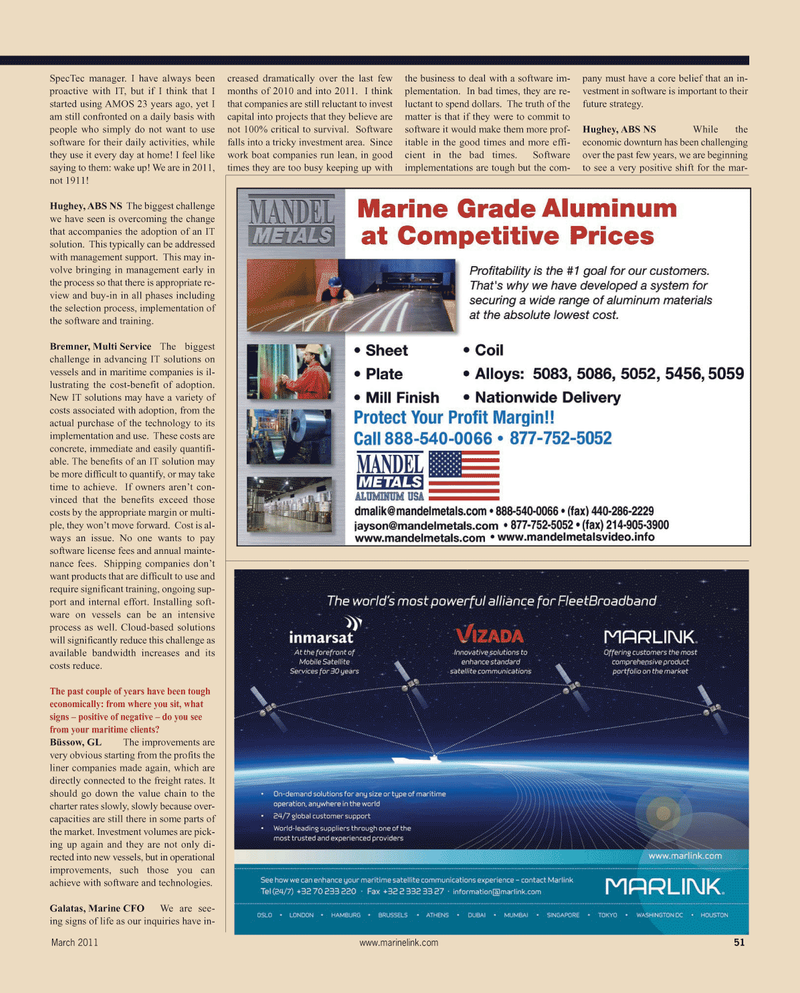
Page 51: of Maritime Reporter Magazine (March 2011)
Ship Repair & Conversion
Read this page in Pdf, Flash or Html5 edition of March 2011 Maritime Reporter Magazine
March 2011 www.marinelink.com 51
SpecTec manager. I have always been proactive with IT, but if I think that I started using AMOS 23 years ago, yet I am still confronted on a daily basis with people who simply do not want to use software for their daily activities, while they use it every day at home! I feel like saying to them: wake up! We are in 2011, not 1911!
Hughey, ABS NS The biggest challenge we have seen is overcoming the change that accompanies the adoption of an IT solution. This typically can be addressed with management support. This may in- volve bringing in management early in the process so that there is appropriate re- view and buy-in in all phases including the selection process, implementation of the software and training.
Bremner, Multi Service The biggest challenge in advancing IT solutions on vessels and in maritime companies is il- lustrating the cost-benefit of adoption.
New IT solutions may have a variety of costs associated with adoption, from the actual purchase of the technology to its implementation and use. These costs are concrete, immediate and easily quantifi- able. The benefits of an IT solution may be more difficult to quantify, or may take time to achieve. If owners aren’t con- vinced that the benefits exceed those costs by the appropriate margin or multi- ple, they won’t move forward. Cost is al- ways an issue. No one wants to pay software license fees and annual mainte- nance fees. Shipping companies don’t want products that are difficult to use and require significant training, ongoing sup- port and internal effort. Installing soft- ware on vessels can be an intensive process as well. Cloud-based solutions will significantly reduce this challenge as available bandwidth increases and its costs reduce.
The past couple of years have been tough economically: from where you sit, what signs – positive of negative – do you see from your maritime clients?
Büssow, GL The improvements are very obvious starting from the profits the liner companies made again, which are directly connected to the freight rates. It should go down the value chain to the charter rates slowly, slowly because over- capacities are still there in some parts of the market. Investment volumes are pick- ing up again and they are not only di- rected into new vessels, but in operational improvements, such those you can achieve with software and technologies.
Galatas, Marine CFO We are see- ing signs of life as our inquiries have in- creased dramatically over the last few months of 2010 and into 2011. I think that companies are still reluctant to invest capital into projects that they believe are not 100% critical to survival. Software falls into a tricky investment area. Since work boat companies run lean, in good times they are too busy keeping up with the business to deal with a software im- plementation. In bad times, they are re- luctant to spend dollars. The truth of the matter is that if they were to commit to software it would make them more prof- itable in the good times and more effi- cient in the bad times. Software implementations are tough but the com- pany must have a core belief that an in- vestment in software is important to their future strategy.
Hughey, ABS NS While the economic downturn has been challenging over the past few years, we are beginning to see a very positive shift for the mar-

 50
50

 52
52
